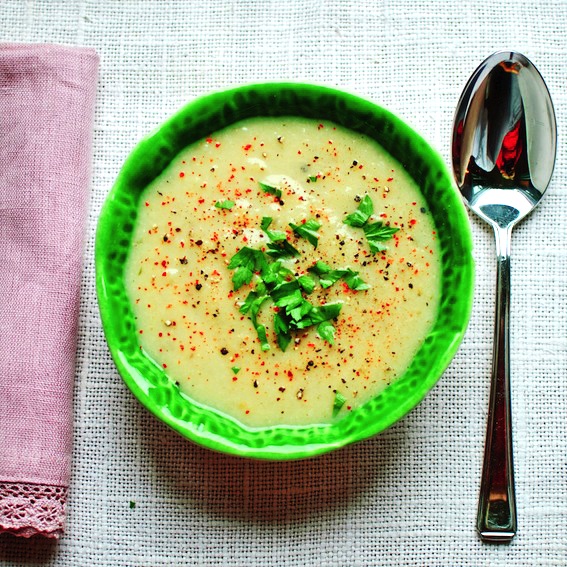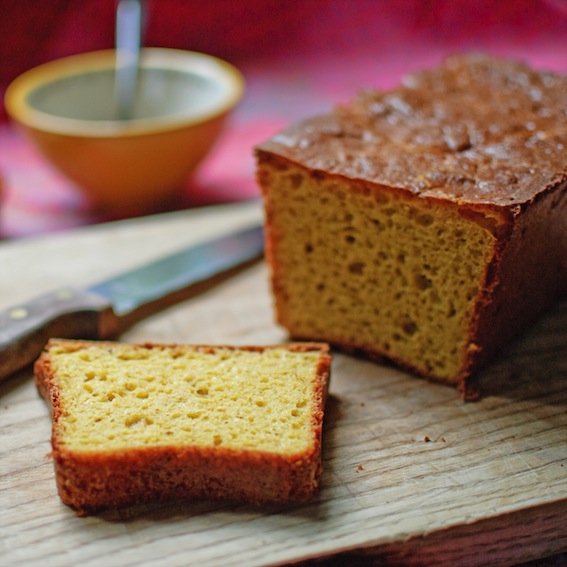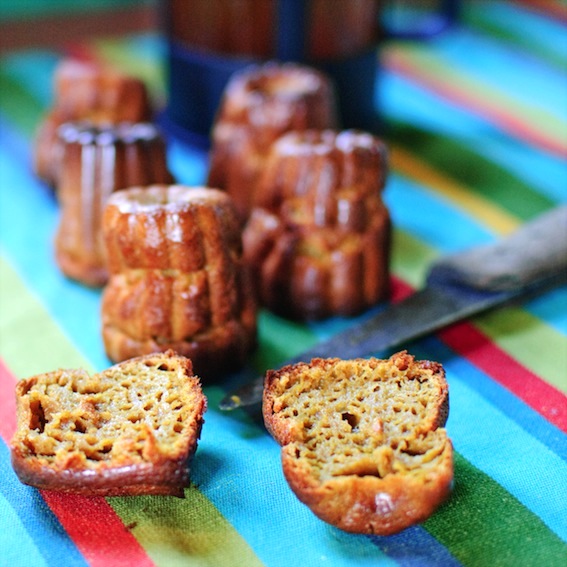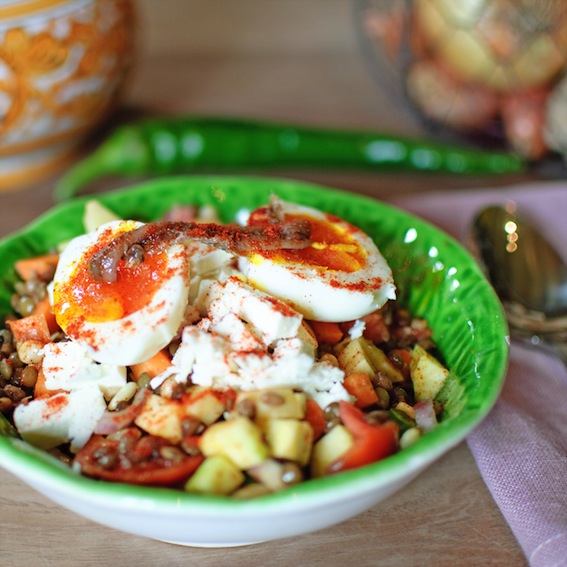-
Raw honey and learning when to stop talking

We went to a local Christmas market this weekend and, while I was busy buying my own bodyweight in locally-produced Landaise honey, Léo was busy consuming his bodyweight in garbure (a duck and vegetable soup typical of Southwestern France). The quantities of food that Léo consumes and the enthusiasm with which he does so, are becoming acute sources of embarrassment to me — you would honestly think that he wasn’t fed at home. Sometimes, for example, we drop into a local café at about 11am for a cup of coffee and he orders a three-course ‘menu du jour’. I desperately feel the need to justify his appetite and end up woefully tying myself in knots with comments like: ‘I do feed him at home you know! In fact I feed him extremely well!’. On realising that this sounds horribly pretentious, I might add: ‘When I say extremely well, obviously I mean, you know, normally. Well not out-of-a-packet normally, but, errr, very healthily’. Of course I end up sounding like a furiously back-pedalling crazy person who should probably learn when to shut up.
Anyway, back to honey. Honey has been used for its healing properties since biblical times when it was used, amongst other things, to treat diphtheria. Physicians of ancient times, such as Aristotle, Hippocrates and Cornelius made reference to its healing qualities. A recent Russian study showed that beekeepers in Georgia who consumed raw honey and pollen on a regular basis frequently lived to over 100, a few even living as old as 150.
Raw honey is honey that has not been heated, pasteurised or processed in any way. It is alkaline-forming and contains a multitude of vitamins, minerals, amino acids, enzymes and powerful antioxidants as well as other natural nutrients. It also contains the enzyme amylase, which aids in the digestion of starch. A piece of toast spread with honey, for example, is more easily digestible than a piece of toast without as the enzymes in the honey ‘predigest’ the starch. (Beware of pasturised honey, which is more or less equivalent to refined sugar.)
Raw honey has anti-viral, anti-bacterial and anti-fungal properties. It promotes general health as well as digestive health and also strengthens the immune system. It helps to control allergies and is an excellent remedy for skin wounds and all types of infections. It can also stabilise blood pressure, balance sugar levels, relieve pain, calm nerves and has been used to treat ulcers. It is an expectorant and has anti-inflammatory properties which means that it is useful in the treatment of respiratory conditions such as bronchitis and asthma.
The different varieties of honey have varying properties as well as quite distinctive aromas. Here are a few:
Acacia, a light and clear honey, is one of the most popular and sweetest honey varieties because of its mild delicate floral taste. Due to its low sucrose content, it is a good choice for diabetics. Acacia cleanses the liver, regulates the intestine, and has an anti-inflammatory action on the respiratory system.
Buckwheat honey is a dark, full-bodied and rich in iron. It contains a higher percentage of antioxidants than other honeys and is perhaps the strongest and darkest of all varieties.
Heather honey is thick, amber in color and has one of the strongest and most pungent flavours. It is fragrant and floral with a very lingering aftertaste that is almost bitter. Prized since ancient times due to its medicinal properties, heather honey is extremely high in protein.
Linden honey is pale yellow in colour with a distinctive yet delicate fresh woody scent. Due to its sedative quality, it is effective in the treatment of insomnia and anxiety. It may also be used to treat colds, coughs and bronchitis.
Pine Tree honey is not overly sweet, has a strong aroma and is rich in minerals and proteins.
Thyme honey’s healing benefits are second to none. It is currently being used in hospitals in France for its infection-fighting, powerful antioxidant properties. A 2009 Greek study found thyme honey to reduce the viability of both endometrial and prostrate cancer cells..
Wildflower honey can vary in colour from very light to dark its flavour ranges from light and fruity to tangy and rich, depending on the mix from the different seasonal wildflowers.
Raw honey should not be given to children under a year old as they lack the stomach acid to de-activate any bacteria. -
French lentil salad with egg and Feta and big noisy puddles
by Hugo, Canine Correspondent
Yesterday we went to visit a huge, noisy puddle. I don’t totally understand how the puddle came about as it hasn’t rained very much recently. Still, I’m only a dog – I can’t be expected to understand everything. They sometimes visit the puddle without me after the first time when I refused to get out of the car. Obviously I wasn’t frightened or anything (I’m a big black scary dog after all), but I didn’t see what there was to get excited about and I’m not a fan of loud noises.
Here is a photo of me in front of the puddle (if I look a bit sad it’s because I had just been told off for spraying sand into their lunch). I wanted to swim but, unlike the puddles near the house, this one moves too much and I find that annoying – it should decide where it wants to be and stick to it. I had great fun chasing away all the noisy white hens though (I assume they were hens – they made an awful racket)…

Everyone seemed to find this lentil salad delicious, although it’s not my bag at all. If dogs were meant to eat lentils they’d be born with big floppy ears and a fluffy tail.
Ingredients (serves 4)
250g Puy lentils, cooked according to instructions
2 tablespoon virgin olive oil
1 tablespoon lemon juice
1 red onion, finely diced
1 carrot, finely diced
8 cherry tomatoes, halved
1 stalk celery, finely diced
2 tablespoons of diced cucumber
100g feta cheese, crumbled
4 free-range organic eggs, softly boiled
4 anchovies
Sea salt and freshly ground black pepper
½ teaspoon paprika
Place the cooked, drained lentils into a salad bowl with the onion, carrot, tomatoes, celery and cucumber. Add the olive oil, lemon juice and salt and pepper and toss well. Crumble the Feta cheese over the top, followed by the halved eggs and anchovies. Sprinkle with paprika and serve. -
Sardine and tomato tart and terribly vain dogs

We recently bought Hugo a new collar and since, he has become more conscious of his appearance than might normally be expected of a dog. He keeps creeping upstairs, which is not really allowed. At first I thought he was coming to remind me to take him for a walk, but quickly realised that he wasn’t looking for me at all; he was looking for the big handsome dog in the mirror at the end of the upstairs hallway. Who knew that a new collar and a mirror could provide so much entertainment? I must hide my camera from him or he’ll be doing ‘selfies’ next! 😉
We still have a steady supply of tomatoes and this was a delicious way to use some up.
Ingredients (serves 6)
Pastry
80g spelt flour
50g chickpea flour
50g butter
2 tablespoons olive oil
Pinch of sea salt
Roughly 6 tablespoons of cold water
Filling
150ml fresh tomato sauce (recipe here)
1 onion (sweet if possible), peeled and sliced
2 tomatoes, sliced
2 cloves of garlic, finely sliced
6 sardine filets
6 anchovy filets
Freshly ground black pepper
1 teaspoon paprika
15g parmesan, grated
Fresh rosemary to garnish
To make the pastry, begin by cutting the butter into small cubes. Sift the flours and a pinch of salt together into in a mixing bowl, also adding the cubes of butter. Rub in and blend by hand until the mixture becomes crumbly. Add the olive oil, combining well and then add the cold water, mixing rapidly with a spoon. Remove the mixture from the bowl onto a lightly floured surface. Knead until you obtain a ball of pastry (if the mixture isn’t ‘sticky’ enough to form a ball, you may need a drop more water). Wrap in a clean cotton tea towel or some cling film and leave to ‘rest’ in the fridge for about two hours. This relaxes the dough and makes it easier to use.
Preheat the oven to 180°C. Roll out the pastry and line a tart tin . The pastry will be quite crumbly so you’ll need to be gentle and patch up the holes. Blind bake the pastry for 12 minutes and then fill with the fresh tomato sauce, onions and sliced tomatoes. Add the sardine filets and anchovies on top. Finally sprinkle with the parmesan, black pepper and paprika and and bake for about 20 minutes. Remove from the oven and add a little fresh rosemary. Serve hot. -
Cream of cauliflower and walnut soup and karmic boomerangs

Hugo has fallen victim to the karmic boomerang and he’s not a happy bunny. His great pleasure in September is to run wild in the corn fields lifting pheasant (and anything else that might be in his wake; he’s not fussy). Of course pheasant and big black monster dogs appearing out of nowhere terrify the horses who carelessly deposit their cargo on the ground and make a run for it, but Hugo doesn’t let this bother him. His latest lifting episode was frenetic enough to cause him what I can only describe as groin strain (I’m assuming that dogs have groins?), poor thing. The good news though is that he’s now housebound for the time being and banned from ‘lifting’, which increases our chances of staying in the saddle for at least the next week or so.
Ingredients
10g butter
1 tablespoon olive oil
1 medium cauliflower, trimed and broken into pieces
1 onion, chopped
1 carrot, chopped
3 tablespoons walnuts, broken into pieces
500ml organic vegetable stock
1 teaspoon cumin seeds
1 bay leaf
1 teaspoon paprika
Salt and freshly ground black pepper
30g cream cheese (such as Boursin)
Parsley and chopped walnuts to garnish
Fry the onions in butter and olive oil in a medium casserole. Add the cauliflower, carrots and walnuts and fry gently for a few more minutes. Add the stock and seasoning and simmer for about 25 minutes or until the vegetables are tender. Add the cream cheese and then purée until smooth. -
Quatre-quarts (pound cake) and irritatingly untidy hens

Things are dodgy here in the canine mental health department — Hugo’s OCD is back with a vengeance. He has decided that the three hens should be together AT ALL TIMES. Apparently stray hens are just too untidy to contemplate. Luckily, the white hen and older red one do seem to stick together (whether through choice or fear of Hugo is unclear). The younger red hen though is a bit of a rebel and seems to enjoy teasing neat-freak dogs. I’ve given up yelling at him for grabbing her by the wings and depositing her in her rightful place next to the others as he doesn’t seem to harm her (beyond making her soggy) and she’s obviously anything but traumatised. He makes the most of having her in his mouth to lick her clean; In Hugo’s world, cleanliness is next to godliness.
Although pound cake (quatre-quarts as it’s called in France) really contains too much sugar to be considered healthy, I’ve tried to make it as unhealthy as possible by using ‘whole’ ingredients. The result is rich, delicious and versatile: a great vehicle for all sorts of toppings or accompaniments.
Ingredients
250g spelt flour
2 teaspoons baking powder
1 teaspoon bicarbonate of soda
125g butter
125g extra virgin organic coconut oil
200g cane sugar
4 large organic eggs
2 teaspoons vanilla essence
1 tablespoon rum
Sift the flour, baking powder and bicarbonate of soda together and set aside. Cut the butter and coconut oil into cubes and leave to soften at room temperature for a few minutes. Beat with an electric mixer for about ten minutes until fluffy and then gradually add the sugar, continuing to beat. Add the eggs one at a time and whisk for another few minutes. Lastly, add the rum and vanilla essence and gently fold in the flour. Transfer the mixture to a buttered loaf tin and cook in a non-preheated oven at 160°C for an hour, or until a skewer comes out clean. Leave to cool in the tin. -
Spelt kuglof and strange dog diets

My husband ceremoniously whipped up and presented Hugo with an an egg-white omelette yesterday. What was that all about do you think? I mean, just how bizarre is it to make an egg-white omelette for a big black labrador? As if the poor mutt doesn’t have enough issues to last a lifetime. Anyway, in a fit of rebellion I poured cream over his kibbles last night (Hugo’s, not my husband’s); he needs to learn to live a bit.
Kuglof (kouglof, kougelhof, kugelhof, kugelopf, kugelhopf or kouglouf) is typically found in Alsace, Germany, Switzerland and Austria. Traditionally it is baked in an earthenware mould with a central funnel, although there are now silicon or aluminium moulds available.
Ingredients
75g raisins
4 tablespoons rum or kirsch
15g bakers yeast
200ml lukewarm milk
500g spelt flour (or plain if you prefer)
1 teaspoon sea salt
75g cane sugar
2 eggs, beaten
75g butter, softened
75g coconut oil, softened (or just use 150g butter)
20g almond flakes
1 tablespoon icing sugar to decorate
Place the raisins in a small bowl and cover with kirsch or rum. Set aside to soak. Mix the yeast with 100ml milk and a tiny bit of flour and leave to double in volume. Mix the remaining flour, salt, sugar, eggs and milk. Beat or knead for about 15 minutes. Add the butter and coconut oil, mixing well. Next add the yeast and knead or beat until the dough becomes detached from the bowl. Cover with a damp tea towel and leave the rise for an hour in warm place (between 25-30°C). Reduce the dough to original volume by gently tapping. Add the soaked raisins and mix. Butter the mould and evenly distribute the flaked almonds in the bottom. Add the dough and leave to rise until it reaches the edge of the mould. Cook for 45 minutes in an oven preheated to 200°C. Once cooked, remove from the mould and decorate with icing sugar. -
Spelt brioche and a water-locked house

We had almost as much rainfall overnight as we usually have during May and June combined. Here it doesn’t rain, but it pours; the house was surrounded by an impressive moat this morning that I don’t recall being there when we signed on the dotted line. We now also boast a second river, which sounds fine in theory, but is not so practical in reality as we’re not very well-equipped boat-wise. Hugo took one look outside this morning and went back to bed, sighing heavily, the hens are developing webbed feet and learning to swim and I was out early drying off the horses with my hairdryer. All-in-all an appropriate morning for brioche.
Ingredients
300g spelt flour (or plain flour if you prefer)
100g butter, melted
100g coconut oil, melted (you can substitute this for a further 100g of butter)
1 teaspoon sea salt
1½ teaspoons dry bakers’ yeast
2 tablespoons cold water
4 eggs, beaten
40g cane sugar
Dilute the dry yeast in 2 tablespoons’ luke-warm water and set aside for 10 minutes. Mix the flour, yeast, salt, sugar, beaten eggs, melted butter and oil. Either knead by hand or beat in a mixer (better if you’re lazy). The dough must stay elastic in consistency so add a drop more water, if necessary. Leave the dough to rise in the mixing bowl for about an hour at a temperature of between 25-30°C (it should double in volume). Beat and knead the dough and leave to rise for a further hour. Beat and knead again and put the dough in the loaf tin. Leave to rise one last time. Preheat the oven to 200°C and cook for 25 minutes. -
Mini salmon terrines and getaway strategies
It’s starting to be tricky to escape in the car alone; Motoring is Hugo’s absolute favourite. He prefers the front seat and I have, in the past, resorted to belting him in rather than take on the chore of coaxing him out of the car. Naturally, he takes it very badly if I kick him out. If, on the other hand, I leave him in the car and need to stop off somewhere, he presses on the horn with his chest if he feels I’ve ‘abandoned’ him for too long. He also dribbles on the seat. So it’s a toss-up between his being put-out and potentially depressed at being ditched, and my being mortally embarrassed by a high-maintenance, disruptive dog and wet front seat. I’m spoilt for choice.
This salmon terrine is an attempt to recreate a dish we had in our hotel in the Pyrenees this winter, as requested by Léo. It is, according to him, ‘quite edible’; Praise indeed. 🙂
Ingredients (makes 6 mini terrines)
2 salmon filets (250g)
juice of half a lemon
25g butter
150ml cream
1 clove garlic, crushed
1 shallot, chopped
½ teaspoon ginger, freshly grated
1 bay leaf
1 tablespoon Pastis
sea salt and freshly ground black pepper
1 teaspoon paprika
4 tablespoons of diced cucumber
4 leaves of fresh mint
2g Agar-Agar powder
Place the salmon filets steeped in lemon juice in a frying pan and add the butter and cream. Bring to a gentle simmer and add all the other ingredients with the exception of the Agar-Agar, cucumber and mint leaves. Simmer for about 10 minutes, until the salmon is cooked through and the liquid partly evaporated. Once cooked, add the mint leaves, blend briefly in a food processor and set aside. Dissolve the Agar-Agar in a small amount of water and bring to the boil (according to the instructions on the packet). Once boiled, mix into the salmon with the diced cucumber and distribute the mixture into moulds (I used silicon muffin moulds). Compact the mixture well. Refrigerate for at least a couple of hours and serve chilled.
-
Canelés de Bordeaux

There is an exquisite patisserie called Pariès in Bayonne, which is the capital of the Basque country in south-western France. They recently produced a book of their recipes, which Idrooled overdiscovered the other day. Bayonne is famous for its chocolate, amongst other things, and was one of the first places in Europe to produce chocolate in the early 17th century. There is always a deliciously rich, chocolate-laden aroma in the streets of the city centre. It’s sometimes worth just strolling around there to get a fix!
I will be sharing some of the chocolate recipes from this absolute gem of a book, but today I made another regional speciality: canelé [kan-ul-ay]. A canelé (or cannelé) is a small French pastry with a moist custard-like centre and a dark, thick caramelized crust. It is the shape of a striated cylinder approximately 5 cms in height and is a specialty of Bordeaux.
These contain too much sugar for me to claim that they’re positively good for you. Having said that, I made them with cane sugar and spelt flour (of course!) and as they contain rich, ‘real’ ingredients they are most definitely a healthier choice as a treat than anything in packaging! I had to make a second batch to photograph because the first batch disappeared far too quickly; They’re that moreish!
Ingredients (makes about 12)
You will need a special canelé mould to make these. The best are made from copper, although I used silicon.
400ml milk
20g salted butter
2 egg yolks
1 egg
140g sugar (I used cane sugar)
120g flour (I used spelt flour)
1 vanilla pod
10cl rum
A little extra butter for greasing the moulds
Beat the egg yolks, egg and sugar in a mixing bowl. Add the flour and vanilla and continue to mix gently. Bring the milk to the boil in a saucepan, remove from the heat and immediately add the butter. When the milk has cooled to lukewarm, add to the other ingredients in the mixing bowl. Mix well. Leave the mixture to rest in the fridge for at least 24 hours, 48 hours if possible. This is important as the mixture must be as ‘airless’ as possible or it will rise during cooking. Also for this reason, it must always be mixed gently, taking care not to add too much air.
To cook the canelés, preheat the oven to 220°C. Remove the mixture from the fridge and very gently stir the (what will now be separated) batter until homogenous. Add the rum at this stage too. Fill the buttered moulds about 7/8 full. Cook for 10 minutes at 220°C and then turn the oven down to 190°C. Cook for a further 40 minutes. Leave to cool before eating. -
Olive, red pepper and anchovy cake and a volatile hoarder
To follow on from this post, unfortunately our black hen died. Hens seem to be so vulnerable to attack from disease, foxes, dogs and perhaps even other hens. I imagined she was suffering from depression when maybe she was just sad to be sick. 🙁
We were (when I say ‘we’ I suppose I mean ‘I’ as, unlike me, neither husband nor son obsesses about our animals) rather worried about the white hen who had disappeared suddenly. We eventually found her over a week later under two enormous bales of hay in a little-used barn, sitting on no fewer than 23 eggs; The little minx had obviously been hiding, laying and hoarding! Don’t ever let it be said that hens can’t multitask. So to add to our animals’ extensive list of mental disorders, we now appear to be the proud owners of a compulsively hoarding hen. Can anyone tell me where I can get my hands on an animal that doesn’t have ‘issues’?
This savoury cake is based on an old French recipe and goes beautifully with soup or hors d’oeuvres. It’s quite light and crumbly and, being made with spelt flour, healthy, wheat-free and low GI.
Ingredients
175g spelt flour
1 teaspoon baking powder
1 teaspoon bicarbonate of soda
1 teaspoon paprika
1 pot of yoghurt (125g)
3 organic eggs, beaten
100ml olive oil
50g red pepper, finely chopped
40g black olives, stones removed
50g sun dried tomatoes
6 anchovies
Preheat the oven to 180°C. Combine the flour, baking powder, bicarbonate of soda and paprika and add the eggs and yoghurt, mixing well. Continue mixing and add the olive oil until you obtain a homogenous paste. Stir in the other ingredients and once well combined, spoon the mixture into a medium-sized, oiled loaf tin. Cook for about 40 minutes, or until a fork comes out clean.



